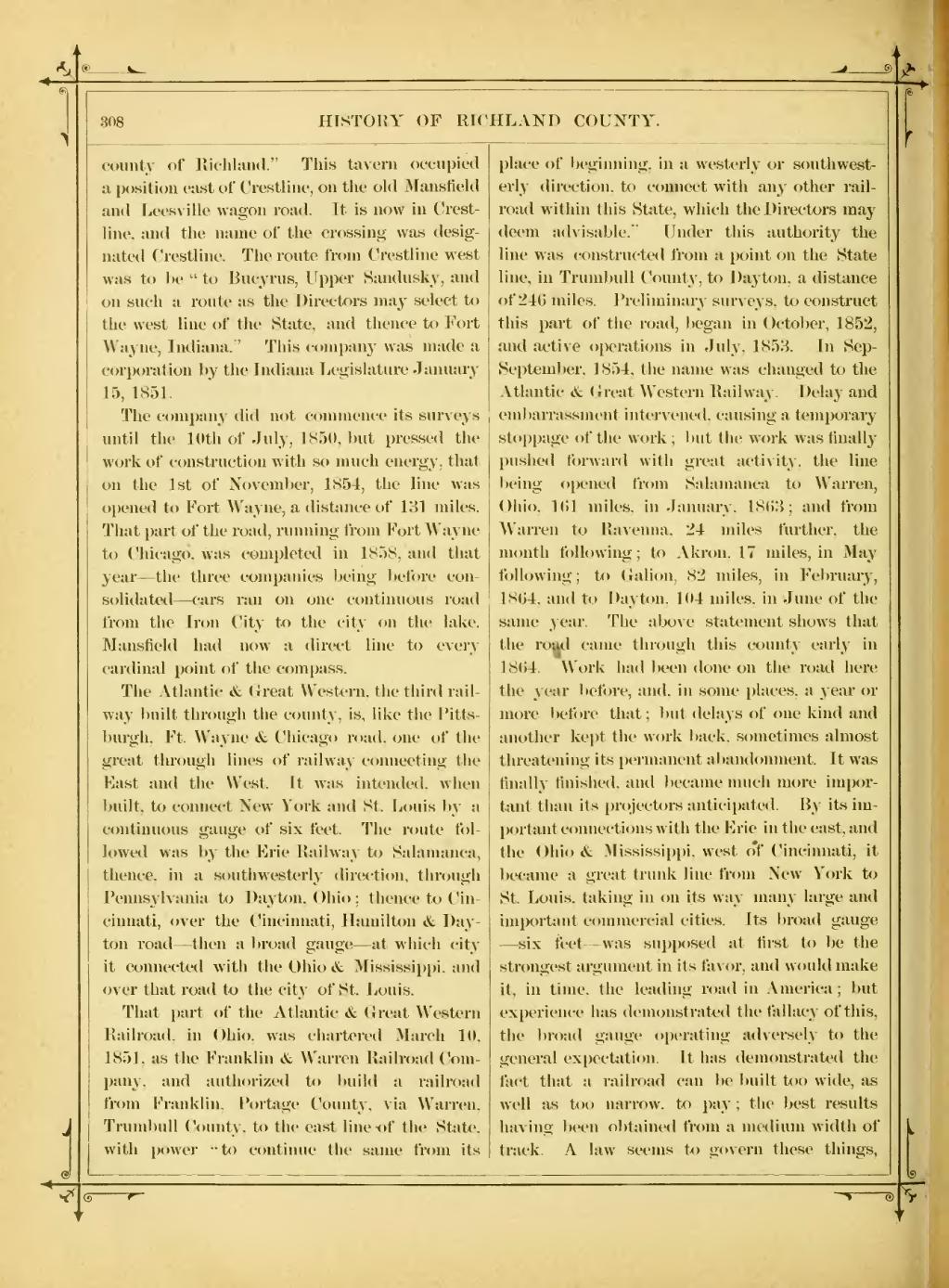��308
��HISTORY OF RICHLAND COUXTY
��county of Richland." This tavern occupied a position east of Crestline, on the old Mansfield and Leesville wagon road. It is now in Crest- line, and the name of the crossing was desig- nated Crestline. The route from Crestline west was to be " to Bueyrus, Upper Sandusky, and on such a route as the Directors may select to the west line of the State, and thence to Fort Wa^'ue, Indiana." This company was made a corporation by the Indiana Legislature Januar}^ 15, 1851.
The compan}^ did not commence its surveys until the 10th of July, 1850, but pressed the work of construction with so much energy, that on the 1st of November, 1854, the line was opened to Fort Wayne, a distance of 131 miles. That part of the road, running from Fort Wayne to Chicago, was completed in 1858, and that year — the three companies being before con- solidated — cars ran on one continuous road from the Iron City to the city on the lake. Mansfield had now a direct line to every cardinal point of the compass.
The Atlantic & Great Western, the third rail- way built through the county, is, like the Pitts- burgh, Ft. Wayne & Chicago road, one of the great through lines of railway- connecting the East and the West. It was intended, when built, to connect New York and St. Louis by a continuous gauge of six feet. The route fol- lowed was by the Erie llailway to Salamanca, thence, in a southwesterly direction, through Pennsylvania to Dayton, Ohio ; thence to Cin- cinnati, over the Cincinnati, Hamilton & Day- ton road — then a broad gauge — at which city it connected with the Ohio & Mississippi, and over that road to the city of St. Louis.
That part of the Atlantic & Grreat Western Railroad, in Ohio, was chartered March 10, 1851, as the Franklin & Warren Railroad Com- pany', and authorized to build a railroad from Franklin. Portage County, via Warren, Truml>ull County, to the east line -of the State, with power -^to continue the same from its
��place of beginning, in a westerly or southwest- erly direction, to connect with any other rail- road within this State, which the Directors may deem advisable." Under this authority the line was constructed from a point on the State line, in Trumbull County, to Dayton, a distance of 246 miles. Preliminary surv^eys, to construct this part of the road, began in October, 1852, and active operations in July, 1853. In Sep- September, 1854, the name was changed to the Atlantic & Great Western Railway. Delay and embarrassment intervened, causing a temporary stoppage of the work ; but the work was finally pushed forward with great activity, the line being oj^ened from Salamanca to Warren, Ohio, 1(31 miles, in January, 1863; and from Warren to Ravenna, 24 miles further, the month following; to Ala'on, 17 miles, in May following; to Gallon, 82 miles, in February, 1864, and to Daj-ton, 104 miles, in June of the same year. The above statement shows that the roatl came through this county early in 1864. Work had l)een done on the road here the year before, and. in some places, a year or more before that ; ])ut delays of one kind and another kept the work back, sometimes almost threatening its permanent aljaudonment. It was finall}' finished, and became much more impor- tant than its projectors anticipated. By its im- portant connections with the Erie in the east, and the Ohio & Mississippi, west of Cincinnati, it became a great trunk line from New York to St. Louis, taking in on its way man}' large and important commercial cities. Its broad gauge — six feet — was supposed at first to be the strongest argument in its favor, and would make it, in time, the leading road in America ; but experience has demonstrated the fallacy of this, the broad gauge operating ad^•ersely to the general expectation. It has demonstrated the fact that a railroad can be built too wide, as well as too narrow, to pay ; the best results having been obtained from a medium width of track. A law seems to oovern these things,
��'\
�� �
